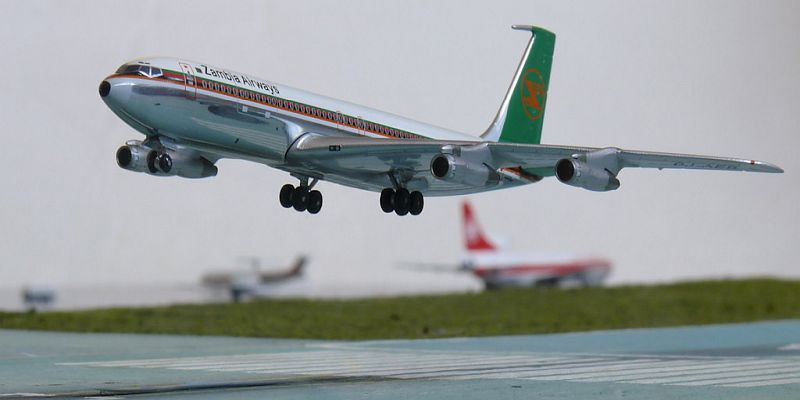Challenges and Opportunities for Sustainable Aviation in Zambia

Zambia is a land locked country in South Central Africa surrounded by 8 countries. The Zambian Government is however, building upon the potential of Zambia being land linked to all her neighbours giving the country its strategic central position and capacity to interlink all these countries’ transport network. My government’s long-term vision is to transform Zambia into a regional transport Hub for all transport modes, namely, air, road, rail and water.
Zambia is also a very diverse country and moving from point to point, using road or rail transport can be challenging as one can take up to 12 hours or more in some cases. This is due to the limited road and rail network, though we are improving this rapidly. Connecting the whole country by road or rail is not easy and requires time. Zambia has since embarked upon massive infrastructure development, including roads, rail, maritime and aviation in order to improve connectivity. However, air transport is not only the fastest and safest mode of transport, but also the most efficient and economical when you consider the savings made in the economy in terms of time, effectiveness of business and loss of human capital to accidents. This is why my government has identified air transport as a key catalyst in sustainable development of the Zambian economy.
Air transport plays a key role in promoting exports, especially horticultural products like fresh organic vegetables, fruits and flowers, also poultry, mineral and precious stones. Air transport is key in promoting Tourism, commerce and trade in Zambia. In other words, air transport is a socio-economic enabler of development in Zambia and other land locked developing countries. Its contribution to the growth and sustenance of such economies cannot be over-emphasised.
However, aviation presents a number of challenges in Zambia, which I will endeavour to outline:
1. Aviation contributes to Carbon Emissions resulting in Air pollution and Climate Change;
2. It also contributes to Water, Soil and Noise pollution which negatively affect land use;
3. Both Aviation Infrastructure development and Air Transport operations are capital intensive and require huge investments;
4. The Yammouskro Decision (YD) has been difficult and slow to implement resulting in limited economic interaction and benefits for African economies; and
5. Limited renewable energy solutions for aviation fuel and lighting at airports.
Allow me now to share some opportunities for aviation in Zambia:
1. Improve the gearing of African economies through the use of the YD which could improve Job opportunities, Mining, Agriculture, Tourism and Trade in Zambia;
2. Zambia has developed its draft Carbon Emissions Reduction Plan to contribute to Climate Change Solutions;
3. We are encouraging private sector involvement in providing solutions for Solid Waste Management as well as Recycling of waste materials;
4. Aviation Infrastructure development and Equipment have been prioritised and linked to the National Budget and National Development Plan;
5. Further, aviation facilitates Humanitarian, disaster responses to crisis and public health emergencies, including Search and Rescue;
6. Recapitalisation of the Air Training Institution to improve Capacity Building capabilities for the aviation sector;
7. Aviation also promotes and facilitates the preservation of Natural and Cultural Heritage; and
8. It facilitates the integration of Drone Technology in Agriculture, Mining, Game Management, Health, City Mapping and Planning, Remote Inspections etc.
Having identified these opportunities, Zambia has invested massively in the aviation sector, starting with the transformation of the Department of Civil Aviation into an autonomous Civil Aviation Authority for the effective regulatory oversight of civil aviation. Government has also focused on the development of new modern international and domestic Aerodromes to conform to ICAO Standards, procured 23 Fire Fighting equipment for all the aerodromes, procured and installed two secondary and primary Radar at Kenneth Kaunda International Airport and Harry Mwaanga Nkumbula International Airport to enhance the safety of civil aviation.
Zambia is one of the few African countries to score an Effective Implementation of more than 60% EI and was removed from the European Union (EU) Ban list in 2016. Further, Zambia is a recipient of the ICAO President’s Certificate this year having met the stringent criteria for its award in 2016.
IATA”s Country Snapshot of Zambia at its IATA Day also heighted the great potential in aviation for Zambia where they projected the Passenger forecast (5 year CAGR, % pa) as World growth of 4.8%, Africa and Middle East at 7.1% and Zambia at 13% year on year growth. This empirical evidence has encouraged Zambia to focus more on investing in aviation and unlocking its potential.
In summation, I wish to reiterate Zambia’s commitment to attainment of the SDGs and sustainable aviation development.
By Yamfwa Mukanga
Minister of Transport, Communications, Works and Supply
Zambia.
